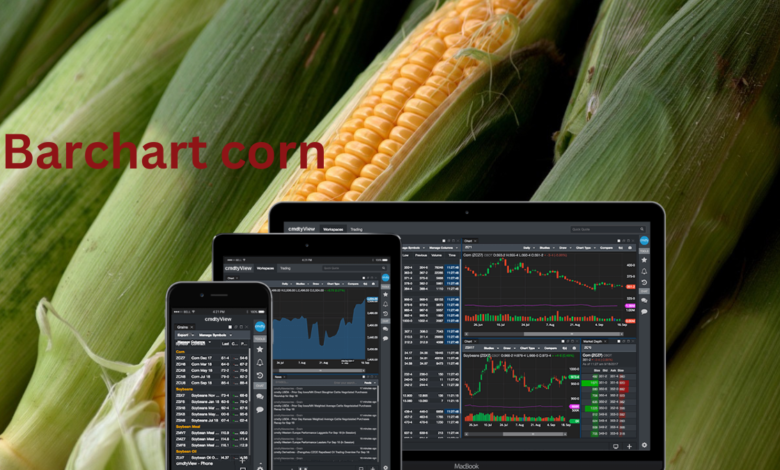Barchart Corn: A Complete Guide to Market Insights and Analysis

In the world of agriculture, barchart corn the ability to predict market trends plays a crucial role in maximizing profits. One essential tool farmers, investors, and traders rely on for this purpose is barchart corn data. Whether you’re trading futures, managing a farm, or simply keeping tabs on commodity markets, barcharts provide the critical data needed to make informed decisions.
This article explores the significance of barchart corn, its role in market forecasting, and how it empowers stakeholders across the agricultural sector. Along the way, we’ll discuss how you can interpret barcharts, monitor corn prices, and stay ahead of market changes.
What Is Barchart Corn?

Barchart corn refers to the price data, trends, and analytics represented in a bar chart format specifically for corn trading. Barcharts visualize fluctuations in corn prices over a specific period, making it easier for traders to track market performance. These charts are particularly useful in futures trading, where timing is everything.
Barcharts showcase key information like:
- Open and close prices
- Highs and lows within a trading session
- Trading volumes
- Historical trends and seasonal patterns
By analyzing a barchart corn graph, traders can gauge market sentiment and predict future movements based on past data.
Why Corn Prices Matter in Global Markets
Corn is a cornerstone crop for both food and energy industries. As a primary ingredient in animal feed, human food products, and biofuels like ethanol, corn prices influence multiple sectors worldwide. Market movements in corn affect the cost of living, farming decisions, and even the stock market.
A rise or fall in barchart corn data can signal global supply-demand shifts due to:
- Weather conditions
- Geopolitical events
- Trade policies and tariffs
- Energy market trends
When investors or agricultural businesses track corn prices using barcharts, they can make smarter decisions to protect themselves from risks and seize new opportunities.
How to Read a Barchart Corn Graph
Reading a barchart corn graph can feel intimidating at first, but once you understand the basics, it becomes second nature. Let’s break down the key elements:
- The vertical bars represent the price range during a specific time frame (daily, weekly, monthly).
- The top of the bar shows the highest price during the session, while the bottom marks the lowest price.
- Horizontal ticks on the bar represent the open and close prices for that time frame.
- Volume bars below the price graph show the total amount of corn traded during that period.
Understanding these components gives traders insight into price momentum, trends, and potential reversals.
The Importance of Seasonal Trends in Barchart Corn Data
Corn markets are highly seasonal. Each year, planting and harvesting cycles have a predictable effect on prices. In most cases:
- Planting season (spring): Prices often rise due to uncertainty around weather and crop success.
- Harvest season (fall): Prices tend to drop as supply increases with newly harvested crops.
- Winter months: Prices may stabilize, but export trends or unforeseen weather events can still cause spikes.
By examining barchart corn trends across seasons, farmers and investors can plan their activities strategically. Traders may hold onto futures during planting to benefit from higher prices or sell off stock when the market peaks just before harvest.
Using Barchart Corn Data for Futures Trading
Corn futures contracts allow buyers and sellers to lock in a price today for future delivery. Futures trading offers protection from price volatility, and barchart corn data plays a central role in managing these contracts.
Here’s how traders leverage barcharts for futures:
- Trend identification: Spotting upward or downward trends to time purchases or sales.
- Technical analysis: Using historical data to predict future movements.
- Hedging strategies: Farmers can secure prices for future harvests, protecting themselves from market drops.
Futures trading requires precision, and without tools like barcharts, traders would struggle to navigate price fluctuations effectively.
Table: Key Factors Influencing Corn Prices
FactorDescriptionImpact on Prices
Weather Conditions Droughts, floods, or ideal weather High variability
Government Policies Subsidies, tariffs, or trade bans Supply chain disruptions
Global Demand Demand for feed, ethanol, and exports Drives market prices
Energy Market Trends Ethanol demand linked to oil prices Indirect price effects
Technological Advances New farming methods or GMOs May reduce production costs
This table highlights how both natural and economic factors impact corn prices, helping traders understand the bigger picture.
How Barchart Corn Tools Benefit Farmers
Farmers aren’t just producers—they’re business managers who need to anticipate market conditions. Using barchart corn data allows farmers to:
- Plan planting and harvesting schedules to align with favorable market conditions.
- Determine storage strategies, deciding whether to sell immediately or store for later gains.
- Access futures markets to hedge against unpredictable price changes.
- Monitor market signals, such as export demands or changing ethanol prices, for quick decision-making.
For modern farmers, tools like barcharts are essential for maximizing profit and minimizing risk.
Barchart Corn in Risk Management
Risk management is a crucial part of any business, especially in agriculture where uncertainty is high. Barchart corn data helps traders and producers manage risks by:
- Spotting price trends early to make timely decisions.
- Creating contingency plans for sudden price drops.
- Using stop-loss strategies in futures trading to minimize potential losses.
For example, if a farmer notices declining trends in a barchart corn graph, they might sell their stored grain sooner to avoid further losses. Similarly, traders can exit futures positions to cut their losses before the market dips too low.
The Role of Technology in Barchart Corn Analysis
Technological advancements have made it easier than ever to analyze and interpret barchart corn data. With the help of AI and machine learning, market predictions are more accurate, and traders can automate many aspects of their strategy.
Some tools that enhance barchart analysis include:
- Mobile trading apps that provide real-time updates on corn prices.
- Algorithmic trading platforms to automate buying and selling.
- Data visualization software for deeper technical analysis.
Technology ensures that farmers, traders, and investors have the tools they need to stay competitive in today’s fast-paced market.
Final Thoughts: Using Barchart Corn for Market Success
Mastering the art of reading and using barchart corn data can open doors to financial success for farmers, traders, and investors alike. With the right strategies in place, these charts offer invaluable insights into price trends, seasonal patterns, and market volatility.
By keeping a close eye on barchart data, you can stay ahead of market changes and make decisions that benefit your bottom line. Whether you’re protecting your farm from unpredictable prices or trading futures on the global market, barchart corn data is your go-to tool for navigating the ever-changing world of agriculture.





